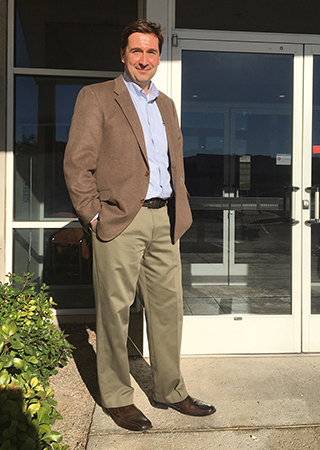Solar entrepreneur Murat Okandan moves with market, gains support

Note: Entrepreneurial life holds both attractions and unknowns for Sandians considering that path. In an effort to shed more light on the realities of starting a high-tech business, the Lab News is following the efforts of the fledgling company mPower to grow its own wings.
On Oct. 2, 2015, our first installment was titled “Why attempt the entrepreneurial life?” and discussed motivations of participants; on Dec 9, personal problems of being without salary yet glimpses of open commercial doors show the dark side and the light; on March 30, 2016, the passion that drives a person to surmount obstacles a realist might consider too large; in a later interview published on the same date, the triumph of bringing on board an experienced business partner and (unnamed) investors, and on July 21, how to get experienced helpers without paying (immediately) for them. The story here is chapter 7 in the ongoing mPower saga.
Murat Okandan, a Sandian on entrepreneurial leave and principal member of the Albuquerque start-up mPower, brought startling news to his most recent interview with the Lab News: The company’s prototypes he will present to colleagues at NASA for testing and possible sale are not tiny wafer-cut samples formed in a microelectronic foundry — a version of the Sandia technology used to build earlier prototypes — but instead are formed from conventional solar photovoltaic industrial processes.
The individual cells, roughly 4 millimeters on a side, are considerably larger than the micron-sized pieces — popularly termed “solar glitter” — that were the object of Sandia research and an early version of the company’s technology since its inception in 2015.
“Metal-oxide semiconductor technology is a more expensive pathway we’re not exercising right now,” says Murat. For the NASA project, the conventionally formed photovoltaic pieces will provide the necessary testing capability, he says, and will be connected in a square array of 24 by 24 pieces, forming an 8 cm square that matches the size of a solar array element already in use at NASA.
Cheaper, lighter, more resilient

Sandia entrepreneur Murat Okandan in the doorway of the building housing mPower offices.
”Our interconnection is key to our prototype’s value,” Murat observes, but says nothing more about it. About other factors, he says, “Our array can generate higher voltages, it’s cheaper, lighter, packs more densely, and is more resilient than what’s currently available: If you knock out one or two of the cells, the system still works,” a comparison with the tendency of ordinary solar arrays to lose significant power when a cell in a large string goes out.
Tests also are ongoing with the Albuquerque-based company Aquila to use the original technology as the basis for a radiation detector. The outlook is promising, he says: “We are talking with potential partners who have expressed interest in the new detector.”
Among a start-up principal’s dreams are investor dollars, and Murat’s company has a backer in entrepreneur Stuart Rose, who is not only the company’s landlord in a building meant for tech start-ups, but also an investor and adviser.
In an informal interview, Rose discusses whether Murat’s company will succeed. “They’re on the right track, but it’s too early to tell,” he says, and describes the difficulty of predicting a winning investment. “Go back in history,” he says. “Someone approaches you and says, ‘I want to make a computer tablet that’s going to cost $1,500 and do everything a desktop or a laptop does.’ Would you invest? Almost everyone would have said ‘no’ — laptops and desktops work great, no need or demand for an iPad.”
Though Murat’s company has potential, Rose says that statistically, six out of 10 companies don’t make it, two scratch on by, one hits singles, and one hits a home run and that one pays for the others. “I can’t predict which one of those companies is going to make it, you just have to go for it: Invest in the company and see what happens.”
“We’re a random variable,” politely agrees Murat.
Rose, who says he has an interest in 16 start-ups, doesn’t comment on mPower’s technology but could discuss when it’s time to hire someone, write a contract, or clarify a business objective.
Says Murat, “I haven’t run a company before, so someone who’s done the early investing stage is a big help.”
Rose says that when he looks at entrepreneurs, he sees a continuity of motivation: from those whose sole intent is to get rich, to those who want to make the world a better place. Murat, he thought, lay more on the “better-place” side.
“Entrepreneurs are really important for New Mexico,” he says. “Big companies with lots of jobs aren’t going to come here,” referring to the relatively small population of qualified workers. Small companies help the local economy, he says, because they often earn money from out-of-state, providing things like coding services or website development.
In the parking lot, Murat says, “A lot of things need to line up for a company to come together. So, no pressure, but you better make it work.”
It seems like pressure. But it seems to be working so far.